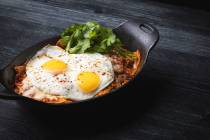Think outside frozen dinners when cooking for yourself



If you live by yourself, you’re definitely not alone.
According to the U.S. Census, one-person households across the country increased to 27 percent in 2010, nearly double the 1960 numbers, when people living alone made up 16 percent of households.
You’d think with such a large proportion of people living alone it would be easier to cook for one, and to a certain extent you’d be right. Marsha Gilford, vice president of public affairs for Smith’s Food & Drug Stores, noted the chain carries single snack packs of carrots and apples, and mini-veggie trays. They also have pre-wrapped baked potatoes that need only be popped into the microwave, "so people can nuke their potato and some broccoli and cheese and you have a meal, basically."
Yen-Soon Kim, a dietitian and assistant professor in the food and beverage management department at the University of Nevada, Las Vegas, said it’s important for solitary cooks to buy fresh fruits and vegetables in small quantities, buying every three or four days. She also suggests buying produce that’s in season, to save money and get the best products.
"If it’s fresh," she said, "they’ll keep eating at home."
There also has been an influx in single-serving puddings and gelatins, which are far less perishable. Whether such produce and grocery packaging came about because of shifting demographics or because more people are packing their own lunches in an effort to save money and eat better is uncertain, but the single household has benefited from the convenience, which extends to the 100-calorie packages, aimed at weight control, that have become ubiquitous.
"And of course, an apple or orange is a single serving," Gilford said, as is a steak or pork chop, which can be purchased singly from the fresh-meat counters of local stores.
But solitary cooks may be surprised to hear that, according to some local chefs who do or have cooked for only themselves at home, leftovers may be their best friend.
"While you’re at it, think ahead," said Lawrence Watson, a chef/instructor at Le Cordon Bleu College of Culinary Arts Las Vegas. "With summer coming, how often do you want to cook? While you’re at it, go ahead and roast a chicken."
Then you can have fresh roast chicken. You can use the carcass for chicken stock. Some of the meat can go into chicken salad, some into chicken enchiladas or other uses.
You won’t want chicken every night, so freeze some of the meat or stock in single-serving containers for later use.
"You’re grilling steak, grill two, maybe three," Watson said. "Or boneless pork loin chops. Use olive oil, but don’t impart too much flavor if you’re not sure what you’re going to do with them."
You can eat one chop the first night. Watson likes to microwave potatoes until they’re slightly soft, brush them with olive oil and Old Bay or other seasoning, then "just mark them on the grill." He’ll cook some green beans until crisp-tender and toss with olive oil and caramelized minced onion.
On another day, he’ll thinly slice a cooked pork chop (kept frozen or refrigerated), along with some onion, celery, radish and cucumber.
"Throw in the green beans that are already garlicky and awesome," he said. Tear up some tortillas (if they’re past their prime, he suggests charring lightly on an open flame) and use them to scoop up the pork-vegetable mixture.
Or make a pork-noodle dish.
"Most people keep dried spaghetti," Watson said. "It doesn’t have to be Asian noodles."
Cook and drain the pasta, he said. Saute some onions and julienned carrot and add some bean paste, chicken stock, sesame oil, slivered leftover meat and the noodles.
Another idea: Make a marinade for skinless, boneless chicken breasts, put each one in a zip-top bag and freeze, so you’re freezing and marinating at the same time.
Barry Dakake, executive chef of N9NE Steakhouse at the Palms, advised solitary cooks not to shy away from recipes that make multiple portions.
"Don’t just cook for one," he said. "Everybody likes a little left over. Sometimes, things you make are great the second day." Dakake said he likes to make mixed-green salads, and "maybe I’ll throw the grill on in the back, make some organic chicken or turkey with rosemary, throw some steaks on the grill."
And don’t be afraid to think simply.
"I love Nathan’s Hot Dogs," Dakake said. "I have a crazy way to do the hot dogs."
He’ll boil them in salted water and steam some buns (with the sides cut off and the edges grilled, like an East Coast split-top hot-dog bun). A native of Rhode Island, he goes online to buy Hot Wiener Sauce Spice Mix, which he cooks with ground beef for a sauce.
And the next day, he may use some of the hot dogs in an egg-white omelet.
Dakake suggested sometimes using a slow cooker so that dinner’s ready at the end of the day.
Geno Bernardo, executive chef at Nove Italiano at the Palms, said he enjoys cooking for himself at home.
"For me it’s fun, because that’s when I get to experiment," he said. "Either I think outside the box and just try something new that I wouldn’t ordinarily cook in the restaurant, or a different type of cuisine I’m not familiar with."
Kim said Thai cuisine, which has become popular in the United States, is easy to prepare in small servings, and is affordable as well. She said Korean cuisine fits the same profile.
Bernardo said that on his days off, he likes to go to 99 Ranch Market in Chinatown or to the Whole Foods Market in Town Square, where a bookstore is nearby. He suggests going to a bookstore to peruse ideas in cookbooks.
Or, he said, turn on the Food Network for ideas and inspiration.
"If it seems too complex, know what you can do and do it the best," he said.
He suggested keeping a journal of what you’ve cooked, with notes on whether it was perfect or ideas on how you can make it better.
"Pretty soon you have your own little recipe and cookbook," he said.
The bottom line:
"It doesn’t have to be a TV dinner in the oven," Bernardo said. "Cooking is fun and easy. Make it simple for yourself. Enjoy what you’re doing."
"The most important thing," Dakake said, "is that when you’re done eating, you want that smile on your face. So always go the next step."
Contact reporter Heidi Knapp Rinella at hrinella@ reviewjournal.com or 702-383-0474.


















